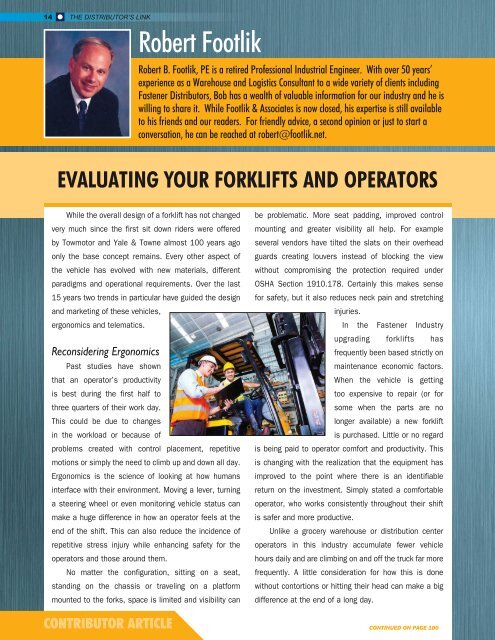SUMMER 2018
Distributor's Link Magazine Summer 2018 / Vol 41 No3
Distributor's Link Magazine Summer 2018 / Vol 41 No3
You also want an ePaper? Increase the reach of your titles
YUMPU automatically turns print PDFs into web optimized ePapers that Google loves.
14<br />
THE DISTRIBUTOR’S LINK<br />
Robert Footlik<br />
Robert B. Footlik, PE is a retired Professional Industrial Engineer. With over 50 years’<br />
experience as a Warehouse and Logistics Consultant to a wide variety of clients including<br />
Fastener Distributors, Bob has a wealth of valuable information for our industry and he is<br />
willing to share it. While Footlik & Associates is now closed, his expertise is still available<br />
to his friends and our readers. For friendly advice, a second opinion or just to start a<br />
conversation, he can be reached at robert@footlik.net.<br />
EVALUATING YOUR FORKLIFTS AND OPERATORS<br />
While the overall design of a forklift has not changed<br />
very much since the first sit down riders were offered<br />
by Towmotor and Yale & Towne almost 100 years ago<br />
only the base concept remains. Every other aspect of<br />
the vehicle has evolved with new materials, different<br />
paradigms and operational requirements. Over the last<br />
15 years two trends in particular have guided the design<br />
and marketing of these vehicles,<br />
ergonomics and telematics.<br />
Reconsidering Ergonomics<br />
Past studies have shown<br />
that an operator’s productivity<br />
is best during the first half to<br />
three quarters of their work day.<br />
This could be due to changes<br />
in the workload or because of<br />
problems created with control placement, repetitive<br />
motions or simply the need to climb up and down all day.<br />
Ergonomics is the science of looking at how humans<br />
interface with their environment. Moving a lever, turning<br />
a steering wheel or even monitoring vehicle status can<br />
make a huge difference in how an operator feels at the<br />
end of the shift. This can also reduce the incidence of<br />
repetitive stress injury while enhancing safety for the<br />
operators and those around them.<br />
No matter the configuration, sitting on a seat,<br />
standing on the chassis or traveling on a platform<br />
mounted to the forks, space is limited and visibility can<br />
CONTRIBUTOR ARTICLE<br />
be problematic. More seat padding, improved control<br />
mounting and greater visibility all help. For example<br />
several vendors have tilted the slats on their overhead<br />
guards creating louvers instead of blocking the view<br />
without compromising the protection required under<br />
OSHA Section 1910.178. Certainly this makes sense<br />
for safety, but it also reduces neck pain and stretching<br />
injuries.<br />
In the Fastener Industry<br />
upgrading forklifts has<br />
frequently been based strictly on<br />
maintenance economic factors.<br />
When the vehicle is getting<br />
too expensive to repair (or for<br />
some when the parts are no<br />
longer available) a new forklift<br />
is purchased. Little or no regard<br />
is being paid to operator comfort and productivity. This<br />
is changing with the realization that the equipment has<br />
improved to the point where there is an identifiable<br />
return on the investment. Simply stated a comfortable<br />
operator, who works consistently throughout their shift<br />
is safer and more productive.<br />
Unlike a grocery warehouse or distribution center<br />
operators in this industry accumulate fewer vehicle<br />
hours daily and are climbing on and off the truck far more<br />
frequently. A little consideration for how this is done<br />
without contortions or hitting their head can make a big<br />
difference at the end of a long day.<br />
CONTINUED ON PAGE 100

















